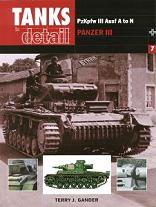
Tanks in Detail - Panzer III
Terry J. Gander
96 pages
published in 2004
Tanks in Detail is one of those overpriced series of military technology books quarely aimed at those of us with war nerd tendencies: short, packed with photos and drawings and going into slightly obsessive detail on a subject normal people at best find boring, at worst somewhat creepy. Reading books on warfare and military history can be justified because war is an important part of our history and it's important to understand it, but you can't justify this sort of book that way. This is for people who like their tanks, people like, well, me. As long as I don't have to pay full whack for this, that is. At 12 pound 99 this isn't exactly cheap for such a slender book, but fortunately the local remainder bookstore had these for five euros each. At that price, it was worth it.
Tanks in Detail - Panzer III is a reasonable introduction to the main German tank of the first half of World War 2, but which contains little that couldn't be found on the internet for free. What makes up for it are the photos and drawings, especially the colour side views at the end of the book showcasing the various camouflage schemes used. There are some good pictures and drawings of the interior of the panzer III as well, showing e.g. the instrument panel and the gun mount. For those interested in such things, like model builders, there are however too few of these drawings to be helpful, nor is it clear which scale is used for the drawings and even dimensions aren't given. It's all a bit slapdash, to be honest.
The focus in this book is completely on the tank itself, with only the bare essentials about its use. In the first chapter the development of the Panzer III is outlined, followed by a more detailed look at the main variants in the second chapter. To showcase the complexity of the Panzer III and the impact it had on production, a late model, the Ausf M is lifted out and described in detail. More exotic variants of the Panzer III, though omitting the important Sturmgeschutz series (which is supposed to have its own entry in this series), are described in the sixth chapter, with details of its production run given in the fifth.
The story of the Panzer III's armament is looked at in chapter four. Throughout its service life the PzKpfw III was capable of being upgunned whenever its opponents started to outmatch it, which says a lot for the basic soundness of the design, though overtly complicated. Originally designed for a 5 cm main gun, the Panzer III started life with a 3.7 cm gun for economical reasons, only to be upgunned back to its original armament, a short 5 cm gun, followed by a more long barrelled variant of same, finally ending with the short 7.5 cm gun originally used on its stablemate, the PzKpfw IV. In the process it also swapped roles with the Panzer IV, turning from a main battle tank to the close support role.
The final chapter takes a quick look at how the Panzer III was used by the Wehrmacht, though it doesn't tell much more than that they were organised in panzer batallions and that there never were enough to go round to properly outfit these batallions. Something that was the case for every tank the Germans used in World War 2. No real details of how it was used in reality rather than theory is provided.
In short, the title of this series is slightly misleading, as most of the information given here is basic stuff familiar to anyone interested in World War II tanks; it's not as if the Panzer III is a particularly obscure tank after all. Then again, much of the attraction of this book is in the photographs and drawings, which as said are ample and nice, though not as detailed as the intended audience probably would like.
Read more about:
Panzer III,
World War 2,
book review